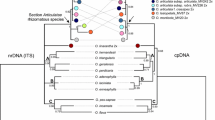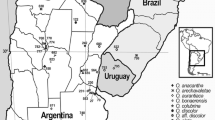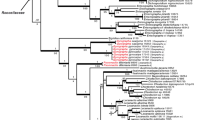Abstract
Genetic relationships for several species of the fungusOmphalotus were estimated by comparing the presence or absence of restriction sites in the ITS1-5.8S-ITS2 region of nuclear ribosomal DNA. Results placeO. olearius, O. subilludens andO. olivascens in a single clade.Omphalotus illudens, usually thought to be related toO. subilludens, was placed in a second clade, more closely related toO. nidiformis. Omphalotus mexicana is distinct from all other examinedOmphalotus species.
Similar content being viewed by others
References
Anderson, J. B., Bailey, J. B., Pukkila, P. J., 1989: Variation in ribosomal DNA among biological species ofArmillaria, a genus of root-infecting fungi. — Evolution43: 1652–1662.
Carlson, J. E., Tulsieram, L. K., Glaubitz, J. C., Luk, V. M. K., Kauffeldt, C. R. R., 1991: Segregation of random amplified DNA markers in F1 progeny of conifers. — Theor. Appl. Genet.83: 194–200.
Felsenstein, J., 1995: PHYLIP (Phylogeny Inference Package) Version 3.5c. University of Washington, Seattle.
Kuyper, T. W., 1995:Omphalotus. — InBas, C., Kuyper, T.W., Noordeloos, M. E., Vellinga, E. C., (Ed.): Flora agaricina Neerlandica,3, pp. 88–89. — Rotterdam: Balkema.
McCleneghan, C., 1997: Systematics of thePholiota alnicola andP. spumosa complexes. — Dissertation, University of Tennessee, Knoxville.
Miller, O. K., 1994: Observations on the genusOmphalotus in Australia. — Mycol. Helv.2: 91–100.
Petersen, R. H., Hughes, K. W., 1998: Mating systems inOmphalotus (Paxillaceae, Agaricales). — Pl. Syst. Evol.211: 217–229.
Phillips, J. D., Forsyth, D., 1972: Plate tectonics, paleomagnetism, and the opening of the Atlantic. — Bull. Geol. Soc. Amer.83: 1579–1600.
Saitou, N., Nei, M., 1987: The neighbor-joining method: a new method for reconstructing phylogenetic trees. — Molec. Biol. Evol.4: 406–425.
Sambrook, J., Fritsch, E. F., Maniatis, T., 1989: Molecular cloning. — Cold Spring Harbor Laboratory Press.
Sneath, P. H. A., Sokal, R. R., 1973: Numerical taxonomy. — San Francisco: Freeman.
Vilgalys, R., 1991: Speciation and species concepts in theCollybia dryophila complex. — Mycologia83: 758–773.
White, T. J., Bruns, T., Lee, S., Taylor, J., 1990: Amplification and direct sequencing of fungal ribosomal RNA genes for phylogenies. — InInnis, M. A., Gelfand, D. H., Sninsky, J. J., White, T. J., (Ed.): PCR protocols, a guide to methods and applications, pp. 315–324. — San Diego: Academic Press.
Wu, Q., Hughes, K. W., Petersen, R. H., 1995: A reevaluation of taxa ofClavicorona subg.Ramosa based on morphology, compatibility and laccase electrophoretic patterns. — Sydowia47: 89–124.
Author information
Authors and Affiliations
Rights and permissions
About this article
Cite this article
Hughes, K.W., Petersen, R.H. Relationships amongOmphalotus species (Paxillaceae) based on restriction sites in the ribosomal ITS1-5.8S-ITS2 region. Pl Syst Evol 211, 231–237 (1998). https://doi.org/10.1007/BF00985361
Received:
Revised:
Accepted:
Issue Date:
DOI: https://doi.org/10.1007/BF00985361




